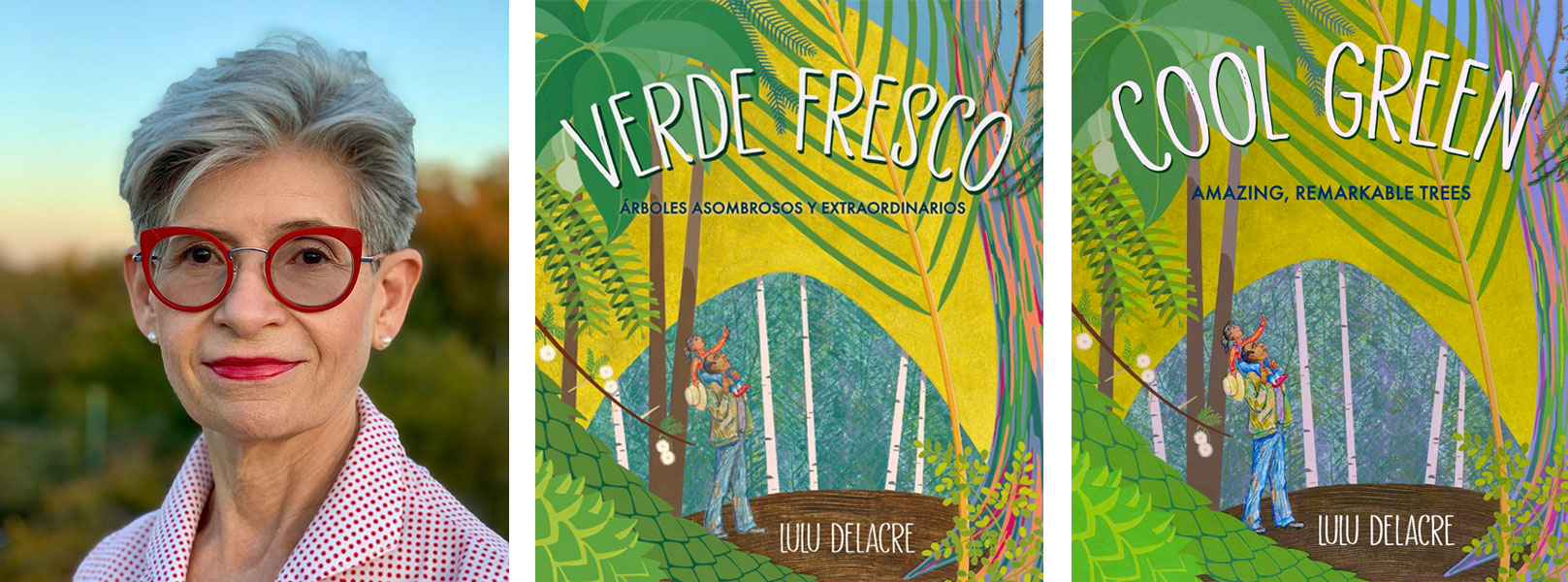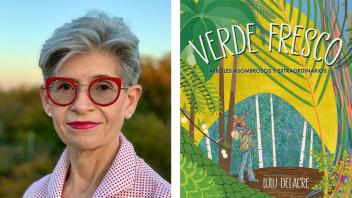Lulu Delacre’s recent book, Cool Green (Candlewick) takes readers on a trip around the world, led by a grandfather with his granddaughter, introducing readers to a range of trees in lyrical text punctuated by fascinating information accompanied by informative and varied illustration. It’s a gorgeous book and Lulu has answered questions that I posed to her.

The dialog between the child and her grandfather begins with him sharing his awe of trees and what they do in the world. How did you discover your awe of trees?
As a young child I used to climb both uva de playa and tamarindo tree in Puerto Rico. I admired the flaming flamboyán flowers. I played with the fallen silver and rust color yagrumo leaves crisp and dry lying on the ground of the tropical rain forest. Later in life, in the house I lived for over three decades, I learned to first plant the trees. By the time we left, river birch, Japanese maple, and Yoshino cherry tree were among the beautiful specimens that shaded a pond teeming with life. The pond became an ecosystem beloved by insects, frogs, songbirds, thirsty squirrels, and the visiting heron.
You used different artistic styles in this book (or are they simply different mediums? Collage, gouache, colored pencil?). Talk about why you chose to vary the art and what you wanted to achieve.
I let the manuscript whisper to me the technique I should use. I also relish a challenge that may allow me to grow as an artist. For nonfiction books that deal with scientific subjects, I like to create accurate but graphic representations. Mixing stylized shapes painted with soft acrylics and collaged papers I had texturized stamping leaves, seemed the right approach. In pasting pressed and dried twigs, leaves, seeds, or flowers from the trees showcased, I sought to echo the catalogs found in natural history museums and research databases. Finally, Abuelo and granddaughter are merely sketched in colored pencil, because in this book, trees are the stars.
You reveal in the backmatter that there are 73,000 species of trees on Earth; that “some 9,000 are believed to be rare, undiscovered, and likely living in remote …” areas of the world. How and why did you choose the 14 that you presented here?
Ahh… I wanted both to share some champions: the tallest, the heaviest, the one with the largest girth, the most colorful, the most ancient; as well as some with intriguing features that may make a child wonder, what other amazing remarkable trees await to be discovered? I thought important to highlight the fact that amazing trees grow all over the globe, and that a tree can be amazing even if it’s humble in its appearance. As the moringa is.
One of my favorite spreads is of the baobab tree. The double page spread is effectively used to bring to contrast wet and dry periods, light and dark. Tell us about this tree and how you decided to present it in this way.
First, the baobab is a tree familiar to many of us, who do not live in its native lands, through great works of literature like the Bible or The Little Prince. It often evokes images of bare branches that look like roots. Second, in showing the tree lush with leaves and heavy scented flowers, I can share facts less known to young readers. Isn’t it cool to think that its flowers open for just one night to be pollinated by bats? Both facts intriguing enough to be the beginning of a short story. Finally, using the gutter to show the tree during both dry and wet seasons, allowed for a streamlined design.
The book is rich in information but is also quite lyrical allowing it to work on two distinct levels: as a poetic sharing between an adult and a child and as a fascinating look into the world of trees (though both serve to inspire). How did you decide how/what information to include in the primary text?
Thank you for noticing the lyrical descriptions. Poetic language mirrors the relationship between Abuelo and granddaughter. Also, the use of rhythm and alliteration, as well as the careful selection of words to convey fascinating facts is my way to lure young readers into wanting to know more about these trees. Readers might be compelled to search the backmatter. Finally, I’d like to think that these descriptions may prompt young writers to add a poem of their own about their favorite tree and become co-authors in doing so.
Tell us about your research for this book.
The truth is that I LOVE research! Assimilating what I learn well enough to be able to convey information in picture book format is as challenging as it is fascinating. I go to great lengths in corroborating facts. Young readers may be less discerning than adults and deserve the best research. Not only did I consult books, but corresponded with scientists, at times specific specialists on one species of tree. I visited arboretums and botanical gardens in search of specimens to make art with. I also had the whole manuscript vetted by W. John Kress, PhD, Curator Emeritus at the Smithsonian Institution.
The child and the adult are Spanish speaking. Additionally, the book was published simultaneously in Spanish and English. Did you translate it, or did you work with a translator?
I take pride in writing in my native language, Spanish. It has been always important to me, as I truly believe that a language is the door to understanding a culture. When I was a young mother it was almost impossible to find beautiful children’s books written in Spanish in the USA; the few translations of classics, often had grammatical errors. I’ve devoted my career to adding titles to the canon of children’s literature that reflect the beauty of the Latino culture and the Spanish language. Verde Fresco: Árboles asombrosos y extraordinarios (Candlewick) is as lyrical as Cool Green. And you know what? It was so much easier to write!
How have you shared the book with children?
Well, funny you ask. I’m so enamored of the powers of the Moringa oleifera, that I’ve sprouted seeds to bring to the schools I visit. There, along with young gardeners, we’ve planted the miracle tree in several states. I have also guided young writers in creating their own poem about their favorite tree to add to Cool Green. And I did not forget the teachers! I worked with an educator to create a comprehensive guide to the book packed with leveled lessons. It’s a free download on my site .
While on my site check the calendar ! The DC Public Library is bringing me to five of its branches. Every child that attends will receive a copy of Cool Green or Verde Fresco.
Is there something we haven’t covered yet that you’d like to include?
Oh yes! There is a new picture book in sight. Veo, Veo, I See You (Atheneum). In this story, set during the recent pandemic, young Marisol learns the true meaning of the word essential. It’s a joyful game, tender, and colorful for the youngest readers. And I did it entirely in collage. Guess why?
Well, Lulu didn’t answer this question, so I guess I’ll just have to wait to find out or come up with my own answer. If you have any ideas, just drop a line to Reading Rockets or ask the kids you live or work with to come up with suggestions as to what collage does better or differently than other art forms. (And if you haven’t tried collage with children, this may be a good time to try it!)
Enjoy Cool Green and other books by this award-winning author/illustrator and be sure to look for Veo Veo which publishes in September 2023.

